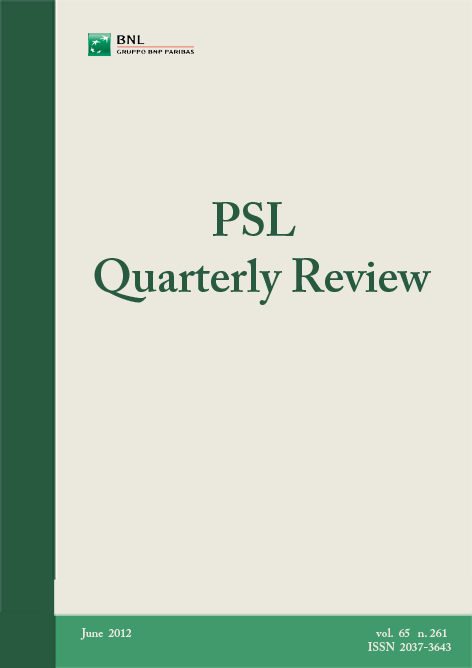Steindl on Stochastic Processes
DOI:
https://doi.org/10.13133/2037-3643/10096Keywords:
Stochastic models, forces of change, Pareto distribution, history matters.Abstract
Steindl’s work on stochastic processes aims to describe the economy as in a state of imbalance, due to the fact that its starting conditions are an accident of history, and nobody has a clue what tomorrow will bring. This does not mean that we cannot imagine a balanced distribution – when the various forces of change are constant – as a way of pointing out certain fundamental characteristics. Such a purpose is compatible with the use of stochastic models, because these also entail the study of systematic phenomena. In fact, what we often describe as ‘random’ is the result of lots and lots of independent forces acting together on a particular phenomenon.
JEL Codes: E12, B16, B25, B31
References
ASIMAKOPULOS A. (1988), Theories of Income Distribution, Boston: Kluwer.
ATKINSON A.B. (1983), The Economics of Inequality, Oxford: Oxford University Press.
BECATTINI G., CASTELLINO O., D’ALAURO O., FUÀ G., LOMBARDINI S., RICOSSA S. and SYLOS LABINI P. (1989), “Economics as Doctrines of Society: An Italian Letter”, Journal of Australian Political Economy, n. 24, pp. 125-8.
CHAMPERNOWNE D.G. (1953), “A Model of Income Distribution”, The Economic Journal, vol. 63 n. 250, pp. 318-351.
CHAMPERNOWNE D.G. (1973), The Distribution of Income Between Persons, Cambridge: Cambridge University Press.
CORSI M. (1991), Division of Labour, Technical Change and Economic Growth, Aldershot: Avebury.
CORSI M. (2005), Le disuguaglianze economiche, (ed.) Torino: Giappichelli.
CORSI M. (2007), “Thinking of Sylos Labini (or Sylos Labini’s Thinking)”, Review of Political Economy, vol. 19 n. 4, pp. 555-62.
FELLER W. (1968), An Introduction to Probability Theory and its Applications, New York: John Wiley and Sons.
GIBRAT R. (1930), Les Inégalités Economiques, Paris: Librairie du Recueil Sirey.
GINI C. (1922), “Indici di concentrazione e di dipendenza”, Biblioteca dell’Economista, series 5, vol. 50, Torino: Unione Tipografico-Editrice Torinese.
GINI C. (1936), “On the Measure of Concentration with Special Reference to Income and Wealth”, in Cowles Foundation for Research in Economics, Report of the II Annual Research Conference on Economics and Statistics, July 6th – August 8th 1936, pp. 73-80.
KALDOR N. (1956), “Alternative Theories of Distribution”, Review of Economic Studies, vol. 23 n. 2, pp. 83-100.
KANBUR S.M.R. (1979), “Of Risk-Taking and the Personal Distribution of Income”, Journal of Political Economy, vol. 87 n. 4, pp. 769-797.
KALECKI M. (1938), “The Determinants of Distribution of the National Income”, Econometrica, vol.6 n.2, pp. 97-112.
KALECKI M. (1945), “On the Gibrat Distribution”, Econometrica, vol. 13 n. 2, pp. 161-170.
KEYNES J.M. (1937), “The General Theory of Employment”, Quarterly Journal of Economics, vol. 51 n. 2, pp. 209-223.
LAMBERT P.J. (2001), The Distribution and Redistribution of Income: Third Edition, Manchester: Manchester University Press.
LOMBARDINI S. and QUADRIO CURZIO A. (1972), La distribuzione del reddito nella teoria economica, Milano: Franco Angeli.
MANDELBROT B. (1960), “The Pareto-Lévy Law and the Distribution of Income”, International Economic Review, vol. 1 n. 2, pp. 79-106.
MILL J.S. (1849), Principles of Political Economy, London: John W. Parker.
MINCER J. (1970), “The Distribution of Labor Incomes: A Survey”, Journal of Economic Literature, vol. 8 n. 1, pp. 1-26.
PARETO V. (1895), “La legge della domanda”, Giornale degli Economisti, vol. 10, pp. 59-68.
RIDOLFI M. (1979), Alfred Marshall e J.M. Keynes: rottura o continuità?, Rimini: Maggioli.
RONCAGLIA A. (2009), “Keynes and Probability: An Assessment”, The European Journal of the History of Economic Thought, vol. 16 n. 3, pp. 489-510.
ROY A.D. (1950), “The Distribution of Earnings and of Individual Output”, Economic Journal, vol. 60 n. 3, pp. 489-505.
RUTHERFORD R.S.G. (1955), “Income Distributions: A New Model”, Econometrica, vol. 23 n. 3, pp. 277-294.
SAHOTA G.S. (1978), “Theories of Personal Income Distribution: A Survey”, Journal of Economic Literature, vol. 16 n. 1, pp. 1-55.
SAY J.B. (1840), Cours complet d'économie politique pratique, Brussels: Soc. Belge de Librairie.
SCREPANTI E. (1990), Teorie della distribuzione del reddito, Milano: Etas Libri.
SIMON H.A. (1955), “On a Class of Skew Distribution Functions”, Biometrika, vol. 42 n. 3-4, pp. 425-440.
SMITH A. (1776), An Inquiry into the Nature and Causes of the Wealth of the Nations, Oxford: Clarendon Press.
STEINDL J. (1965), Random Processes and the Growth of Firms, London: Hafner.
STEINDL J. (1972), “The Distribution of Wealth after a Model of Wold and Whittle”, Review of Economic Studies, vol. 39 n. 3, pp. 263-280.
STEINDL J. (1990), Economic Papers 1941-88, London and Basingstoke: Macmillan, pp. 328-355.
STEINDL J. (1978), “The Pareto Distribution”, in Kruskol W.H. and Tanur J. (eds.), International Encyclopedia of Statistics, New York: Macmillan.
STEINDL J. (1990), Economic Papers 1941-88, London and Basingstoke: Macmillan, pp. 321-327.
STEINDL J. (1984), “Reflections on the Present State of Economics”, Banca Nazionale del Lavoro Quarterly Review, vol. 37 n. 148, pp. 3-14.
STEINDL J. (2012), “Reflections on the Present State of Economics”, PSL Quarterly Review, vol. 65 n. 261, pp. 199-212.
STEINDL J. (1987), “Pareto Distribution”, in Eatwell J., Milgate M. and Newman P. (eds.), The New Palgrave: A Dictionary of Economics, vol. 3, London and Basingstoke: Macmillan, pp. 809-11.
STEINDL J. (1990), Economic Papers 1941-88, London and Basingstoke: Macmillan.
STEINDL J. (1990), “The Personal Distribution of Income”, in Steindl J. (1990), Economic Papers 1941-88, London and Basingstoke: Macmillan , pp. 356-370.
STEINDL J. (1990), “The Dispersion of Expectations in a Speculative Market”, in Steindl J. (1990), Economic Papers 1941-88, London and Basingstoke: Macmillan, pp. 371-375.
SYLOS LABINI P. (2002), “Il mestiere dell’economista tra analisi teorica e impegno sociale”, Working Paper Series, n. 52, Milano: Department of Economics, University of Milano – Bicocca.
TINBERGEN J. (1956), “On the Theory of Income Distribution”, Weltwirtschaftliches Archiv, vol. 77, pp. 155-175.
WOLD H.O.A. and WHITTLE P. (1957), “A Model Explaining the Pareto Distribution of Wealth”, Econometrica, vol. 25 n. 4, pp. 591-595.
Downloads
How to Cite
Issue
Section
License



